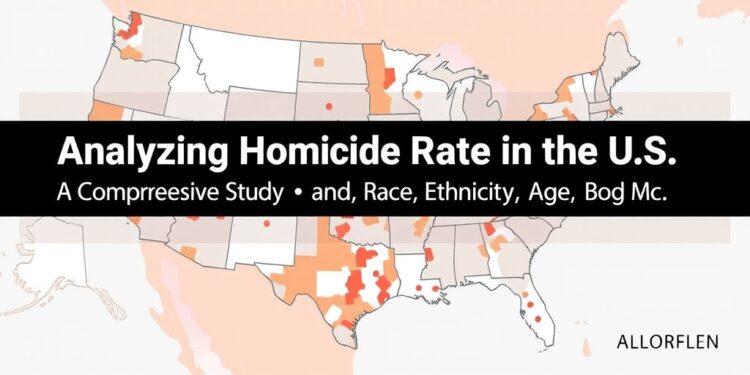Analyzing Homicide Rates in the U.S.: A Comprehensive Study of County, Race, Ethnicity, Age, and Gender
Analyzing Homicide Rates in the U.S.: A Comprehensive Study of County, Race, Ethnicity, Age, and Gender

In the complex tapestry of societal issues, homicide rates present a grim tableau that demands urgent attention. A recent cross-sectional study exploring U.S. homicide rates unveils disturbing trends that exhibit substantial variations, influenced by factors such as county, race, ethnicity, sex, and age groups. Particularly alarming is the finding that American Indian and Alaska Native, along with Black males aged 15 to 44, are subject to the highest homicide rates. These revelations not only spotlight specific demographic vulnerabilities but also underscore an acute need for awareness and proactive violence prevention measures in these communities.
Analyzing the data further, it becomes clear that these alarming rates do not merely derive from isolated incidents; rather, they reflect systemic issues rooted in socio-economic disparities, historical marginalization, and varying access to resources. Urban areas, often characterized by higher poverty rates, struggle with violence far more than their suburban counterparts. Such environments, fraught with economic instability and fewer opportunities, generate conditions where crime, including homicide, is more likely to thrive.
Moreover, the implications of this study extend beyond mere statistics. For many families in these high-risk communities, the shadow of homicide is not a distant threat but a daily reality. The trauma associated with violence—particularly homicides—permeates throughout families and neighborhoods, creating cycles of fear and retaliation. It undermines community structures, preventing residents from safely engaging in everyday activities.
The demographic breakdown provided by the study sheds light on the disproportionate impact felt by specific groups. The findings indicate a historical resonance; these groups have long contended with factors contributing to their heightened exposure to homicide, such as economic disenfranchisement and social exclusion. As these communities grapple with both cultural and systemic challenges, the importance of tailored intervention strategies becomes paramount.
In addition to sociocultural elements, a closer examination reveals the roles of access to mental health and social services. Individuals grappling with mental health issues, particularly in underserved populations, are often at heightened risk of both committing and falling victim to violence. Moreover, a lack of resources focused on rehabilitation and conflict resolution exacerbates these dangers, creating a vicious cycle wherein those in need cannot access the support necessary to pursue positive life trajectories.
The call to action emphasized by the researchers serves as both a warning and an opportunity. Elevated homicide rates illuminate the urgent need for comprehensive violence prevention programs and public health approaches, specifically aimed at the most affected populations. Community-based initiatives can play a crucial role in fostering resilience and fortifying community bonds, ultimately leading to safer environments. Strategies that engage local leaders, promote social cohesion, and build trust between citizens and law enforcement are vital for enhancing overall community safety.
Crucially, the study also highlights the role of government entities in addressing these pressing concerns. Policymakers have a unique responsibility to enact legislation designed to mitigate the factors contributing to violence. Investments in education, public health, and economic development in high-risk areas can yield substantial payoffs, not only in terms of reduced homicide rates but also in improving overall quality of life.
Despite the grim findings of the study, there is also room for hope. Researchers emphasize that awareness is the first step toward transformation. By shining a light on the communities and demographics most affected by homicide, we elevate the discourse surrounding gun violence and systemic inequality. Engaging the media, community leaders, and policymakers in these conversations can lead to much-needed advocacy and change.
In conclusion, while the data presents a daunting challenge, it simultaneously offers a pathway for meaningful action. The responsibility now lies with society at large—to recognize the complexities of homicide rates across different demographics and to mobilize resources aimed at fostering safer communities. By addressing the underlying causes that contribute to violence, we can begin to cultivate a landscape where fewer lives are lost to homicide and healing can begin in the affected communities.
Engaging with these issues is not simply an academic exercise. Rather, it represents a societal obligation to safeguard the well-being of all individuals, particularly those who have been marginalized and disproportionately affected by violence. The urgency of these findings compels us to reconsider our strategies for intervention and the societal structures that contribute to these tragic outcomes.
By prioritizing awareness and prevention, we can strive to change the narrative surrounding homicide rates and work towards a future where all individuals, regardless of their background, are afforded safety, dignity, and the potential for growth.
Subject of Research: Homicide Rates in the U.S.
Article Title: Dissecting Disturbing Trends: The Homicide Crisis in America
News Publication Date: [Publication Date]
Web References: [Web References]
References: [References]
Image Credits: [Image Credits]
Keywords: Homicide, Violence Prevention, Social Inequality, Demographics, Crime Rate.
China’s Journey to Carbon Neutrality: Committing to the Paris Agreement’s 2°C Goal
Next PostRevolutionizing Structure Monitoring: Innovative Self-Sensing Composite Bars Enhance Reinforced Concrete Systems
Gene Body Methylation Drives Diversity in Arabidopsis







